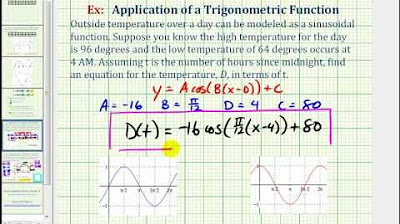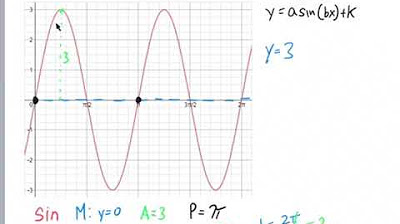Sine & Cosine Graphs Word Problems (Writing the Equation)
TLDRThis educational video script focuses on solving word problems involving periodic functions where the equation is not given. The presenter illustrates how to derive the equation for a periodic function by using two examples. The first example involves calculating the height of a boat above the ocean floor during tidal changes, using a cosine function with a 12-hour period. The second example models the variation in the number of visible sunspots over an eight-year period, also using a cosine function. The script emphasizes finding the midline, amplitude, and period to construct the function, and it provides a step-by-step approach to graphing and writing the equation for each scenario.
Takeaways
- 🌊 The video focuses on solving periodic function word problems where the equation is not given and must be derived from the information provided.
- 📚 The first example discusses the periodic nature of tides, where the height of a boat above the ocean floor changes from 8 feet at low tide to 44 feet at high tide after six hours.
- 📉 The midline of the function is calculated as the average of the minimum and maximum values, which in the first example is 26 feet (the average of 8 and 44).
- 📈 The amplitude (a) is determined by the distance from the midline to the maximum or minimum value, which is 18 feet in the first example (44 - 26 or 26 - 8).
- 🔍 The period of the function is given as 12 hours, from low tide to high tide and back to low tide, which is used to calculate the b value.
- 🔢 The b value is calculated using the formula 2π divided by the period, resulting in π/6 for the first example.
- 📊 The function is graphed to visualize the periodic nature of the problem, with the graph starting at a minimum and reflecting the periodic rise and fall.
- 📝 The equation for the first example is derived as \( y = -18\cos(\frac{\pi}{6}x) + 26 \), using cosine due to the starting point at a minimum and a negative amplitude for the vertical reflection.
- 🌟 The second example involves modeling the number of visible sunspots, which varies from a minimum of 20 to a maximum of 100 over an eight-year period.
- 📅 The last maximum sunspot activity occurred in 2014, and the function is graphed to reflect this periodicity, with peaks and troughs occurring every four years.
- 📑 The equation for the sunspot example is \( y = 40\cos(\frac{\pi}{4}x) + 60 \), using the amplitude of 40, the b value of π/4, and a vertical shift to reflect the midline.
Q & A
What is the main focus of the video on periodic function word problems?
-The main focus of the video is to teach how to write the equation of a periodic function when it is not given, using examples to illustrate the process.
What is the first example problem discussed in the video?
-The first example problem is about the tide's periodic function, where the height of a boat docked in the harbor changes from 8 feet above the ocean floor at low tide to 44 feet above at peak high tide.
How is the midline of a periodic function determined in the video?
-The midline is determined by finding the average of the minimum and maximum values, which in the case of the tide example, is the average of 8 feet and 44 feet, resulting in 26 feet.
What is the amplitude in the context of the tide example?
-The amplitude is the vertical stretch or distance from the midline to the maximum or minimum value. In the tide example, it is 18 feet, calculated as either 44 - 26 or 26 - 8.
Why is the cosine function used instead of the sine function in the tide example?
-The cosine function is used because the tide starts at its minimum value (low tide), whereas the sine function would be more appropriate if the tide started at the midline.
How is the b value of a periodic function calculated in the video?
-The b value is calculated by dividing 2π by the period of the function. For the tide example, the period is 12 hours, so b is 2π/12, which simplifies to π/6.
What does the negative sign in front of the amplitude in the tide example represent?
-The negative sign represents a vertical reflection of the cosine function, which is necessary because the tide starts at a minimum rather than a maximum.
What is the second example problem discussed in the video?
-The second example problem is about the number of visible sunspots, which varies from a minimum of about 20 to a maximum of about 100 per year, repeating over an eight-year period.
How is the midline determined for the sunspot example?
-The midline for the sunspot example is determined by averaging the minimum and maximum values, which is 60 (the average of 20 and 100).
What is the amplitude of the sunspot example?
-The amplitude of the sunspot example is 40, which is the distance from the midline to the maximum or minimum value, calculated as either 100 - 60 or 60 - 20.
How is the b value calculated for the sunspot example?
-The b value for the sunspot example is calculated by dividing 2π by the period of eight years, resulting in b = π/4.
How does the video suggest writing the equation for the sunspot example?
-The video suggests writing the equation as y = 40cos(π/4x) + 60, where 40 is the amplitude, π/4 is the b value, and 60 is the midline representing the vertical shift.
Outlines
🌊 Tidal Function Modeling
This paragraph discusses the process of creating a mathematical model for a periodic function, specifically using the example of tidal changes. The video explains how to derive the equation for the height of a boat above the ocean floor over time, given the boat's height at low tide and high tide, and the time between these two extremes. The approach involves calculating the midline (average of minimum and maximum heights), amplitude (half the difference between the maximum and minimum heights), and the period of the function. The video also covers how to determine the b value (angular frequency) using the formula 2π divided by the period. The final equation is formulated as a cosine function with a negative amplitude to reflect the starting point at low tide, with no horizontal shift, and is graphed accordingly.
🌟 Sunspot Cycle Modeling
The second paragraph focuses on modeling the periodic variation in the number of visible sunspots as a cosine function of time. The video provides details on how to calculate the midline and amplitude from the given minimum and maximum sunspot numbers. It explains that the midline is the average of the minimum and maximum values, and the amplitude is half the difference between these two values. The b value (angular frequency) is determined by dividing 2π by the period of the phenomenon, which is given as an eight-year cycle. The video then guides through graphing the function and writing the final cosine equation, which includes the amplitude, b value, and vertical shift to account for the midline. The example also specifies that the last maximum occurred in 2014, which helps in graphing the function over time.
Mindmap
Keywords
💡Periodic Function
💡Cosine Function
💡Amplitude
💡Midline
💡Period
💡Horizontal Shift
💡Tide
💡Sunspots
💡Equation Writing
💡Graphing
Highlights
Introduction to the second video on periodic function word problems.
Focus on writing the equation for periodic functions when not given.
Example of tide levels as a periodic function.
Low tide is 8 feet above ocean floor, high tide is 44 feet above.
Writing a function to represent the height of the boat above the floor over time.
Choosing the cosine function over sine for the periodic function.
Calculating the midline as the average of minimum and maximum values.
Determining the amplitude as the distance from the midline to the maximum or minimum.
Finding the period of the tide to calculate the b value.
Understanding the 12-hour period of the tide cycle.
Graphing the periodic function without horizontal shift.
Writing the equation for the tide's height over time.
Second example involving sunspots and their periodic variation.
Sunspots vary from a minimum of 20 to a maximum of 100 per year.
The variation repeats over an eight-year period.
Writing a cosine function to model the sunspot phenomenon.
Calculating the midline and amplitude for sunspot numbers.
Determining the b value for the sunspot periodic function.
Graphing the sunspot periodic function and writing the equation.
Transcripts
Browse More Related Video

Sinusoidal Function Word Problems: Ferris Wheels and Temperature

Ex: Model Daily Temperatures Using a Trig Function

Writing Equations for Sinusoidal Functions

Ferris Wheel MHF4U Modelling Trigonometric Functions Test

Finding the equation of a periodic function from a graph or sketch

The Ferris Wheel - Trigonometric Function Model (1 of 3: Setting up the equation)
5.0 / 5 (0 votes)
Thanks for rating: